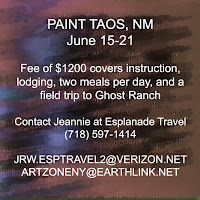Artists are, for the most part, practical chemists with no education in the subject.
 |
|
Pedernal, 1941, Georgia O’Keeffe, courtesy Georgia O’Keeffe Museum. All three paintings in this post have been identified as suffering from saponification.
|
For decades, conservationists, scholars and even
Georgia O’Keeffeherself assumed that the tiny bumps along her paintings were grains of sand from the desert of New Mexico. Eventually, those bumps began to grow and flake off.
The bumps are metal soaps, formed by a chemical reaction between lead and zinc pigments and the fatty acids in the linseed oil binder. Medieval alchemists made boiled linseed oil by exploiting this same reaction, tossing lead oxide in to make the oil thicken.
O’Keeffe’s paintings aren’t the only ones suffering from these surface pimples. The problem is found in works by artists as diverse as Rembrandt and Vincent Van Gogh. As many as seven in ten museum masterpieces may be affected.
 |
|
The Anatomy Lesson of Dr Nicolaes Tulp, 1632, Rembrandt courtesy the Mauritshuis
|
Anecdotal evidence shows that moving paintings, exposing them to daylight, and changes in humidity contribute to the problem. “There seems to be some correlation between the number of times the paintings have traveled to public exhibitions and the size and maturity of the surface disruption. The more times the paintings have traveled, the more likely it will be that the protrusions are larger and more numerous,
saidDale Kronkright, head of conservation at the Georgia O’Keeffe Museum.
 |
|
Detail of Madame X (Madame Pierre Gautreau), John Singer Sargent, 1884, showing saponation in the black dress.
|
To test this theory, a team from Northwestern’s McCormick School of Engineering has developed a handheld scanner to document continuing changes in painting.
“If we can easily measure, characterize and document these soap protrusions over and over again with little cost to the museum, then we can watch them as they develop,”
saidOliver Cossairt, an associate professor of computer science at McCormick. “That could help conservators diagnose the health and prescribe treatment possibilities for damaged works of art.”
What does this have to do with us working artists? After all, we’re not using lead paint anymore, and if we’re smart, we don’t use zinc white, either. The problem is, most artists are all practicing chemistry with very little education in the subject, self included.
 |
|
Falling Leaves, 1888, Vincent Van Gogh, courtesy Van Gogh Museum
|
Don’t think you’re getting away from the metals because you’ve moved to a modern palette. Metals are naturally-occurring elements of great usefulness, and that includes making pigments. An incomplete list of the metal pigments we currently use includes cobalt blue and violet, manganese blue and green, ultramarine blue, the cadmiums, Prussian blue, viridian, the iron oxide pigments (sienna, umber, and black), and titanium white. In other words, you can’t get away from them. Nor can you get away from the fatty acids in oil binders. Whatever the binder you’re using—walnut oil, beeswax or linseed oil—it’s an organic fatty acid.
This process of saponification is also what is going to make you and I dissolve into a pile of
grave wax someday. Even the ancients knew that nothing lasts forever: “Then I considered all that my hands had done and the toil I had expended in doing it, and behold, all was vanity and a striving after wind, and there was nothing to be gained under the sun,” (Eccl 2:11)
Meanwhile, we’ve managed to keep paintings intact for
a few thousand yearsand we can continue to do just that. Just continue to paint fat over lean, avoid known fugitive or reactive pigments, and don’t follow untried, crackpot approaches, and your work should last a long time.



















